BATTERY_MODULE
Specifies a battery module and its parameters.
Type
AcuSolve Command
Syntax
BATTERY_MODULE("name") {parameters...}
Parameters
- number_of_parallel_cells (int) ≥1 [=1]
- Number of cells connected in parallel in a battery module for each serial unit. For example, for a 4s2p battery pack the number of parallel cells is 2.
- number_of_serial_cells (int) ≥1 [=1]
- Number of parallel units connected together in series. For example, for a 4s2p battery pack the number of serial cells is 4.
- number_of_parallel_connected_units (int) ≥1 [=1]
- Number of parallel connected units in the module configuration. For example, in a 4s2p battery module 2 parallel connected units means two sub-units of size 2s2p are connected.
- electrical_input_type (enumerated) [=current]
- Type of global electrical input to battery module.
- current
- Electric current input. Requires current_type.
- c_rate
- C-rate input. Requires c_rate_type.
- voltage
- Voltage input. Requires voltage_type = constant.
- power
- Power input. Requires power_type.
- standard_charge_profile
- Pre-defined charging profile.
- current_type (enumerated) [=none]
- Type of electrical current input.
- constant or const
- Constant electrical current. Requires current.
- piecewise_linear or linear
- Piecewise linear curve fit electrical current profile. Requires curve_fit_values and curve_fit_variable.
- cubic_spline or spline
- Cubic spline curve fit electrical current profile. Requires curve_fit_values and curve_fit_variable.
- current (real) [=0]
- Constant value of electrical current. When current_type is constant. Notice you have positive current for discharging and negative current for charging.
- current_curve_fit_values (array) [={0,0}]
- A two-column array of independent-variable/isotropic electrical current data values. The independent variable is either state of charge or time. Used with piecewise_linear and cubic_spline types.
- current_curve_fit_variable (enumerated) [=time]
- Independent variable of the curve fit for isotropic electrical current. Used
with piecewise_linear and
cubic_spline types.
- time
- time
- c_rate_type (enumerated) [=none]
- Type of c-rate input.
- none
- No c-rate type specified.
- constant or const
- Constant c-rate value. Requires c_rate.
- piecewise_linear or linear
- Piecewise linear curve fit c-rate profile. Requires curve_fit_values and curve_fit_variable.
- cubic_spline or spline
- Cubic spline curve fit c-rate profile. Requires curve_fit_values and curve_fit_variable.
- c_rate (real) [=0]
- Constant value of c-rate. When type is constant.
- c_rate_curve_fit_values (array) [={0,0}]
- A two-column array of independent-variable/isotropic c-rate data values. The independent variable is time. Used with piecewise_linear and cubic_spline types.
- c_rate_curve_fit_variable (enumerated) [=time]
- Independent variable of the curve fit for isotropic c-rate. Used with
piecewise_linear and
cubic_spline types.
- time
- time
- voltage_type (enumerated) [=constant]
- Type of voltage input.
- constant or const
- Constant voltage value. Requires voltage.
- voltage (real) [=0]
- Constant value of module input voltage. When voltage_type = constant.
- power_type (enumerated) [=constant]
- Type of power input.
- constant or const
- Constant power value. Requires power.
- piecewise_linear or linear
- Piecewise linear curve fit power profile. Requires curve_fit_values and curve_fit_variable.
- cubic_spline or spline
- Cubic spline curve fit power profile. Requires curve_fit_values and curve_fit_variable.
- power (real) [=0]
- Constant value of module input power. When power_type = constant. Input can be positive or negative.
- power_curve_fit_values (array) [={0,0}]
- A two-column array of independent-variable/isotropic power data values. The independent variable is time. Used with piecewise_linear and cubic_spline types.
- power_curve_fit_variable (enumerated) [=time]
- Independent variable of the curve fit for power. Used with
piecewise_linear and
cubic_spline types.
- time
- time
- charging_profile_type (enumerated) [=none]
- Type of power input.
- none
- No charging profile used.
- constant_current_constant_voltage or cccv
- Constant current constant voltage charging profile. Requires a module input current or c_rate to be specified.
- constant_power_constant_voltage or cpcv
- Constant power constant voltage standard charging profile. Requires module power to be specified.
- cut_off_current_percent (real) [=0.01]
- Current at which the battery is considered fully charged when using charge profiles.
- maximum_cell_voltage (real) [=4.20]
- Maximum allowed voltage of an individual battery cell. This avoids overcharging.
- minimum_cell_voltage (real) [=3.0]
- Minimum allowed voltage of an individual battery cell.
- maximum_cell_state_of_charge (real) [=0.95]
- State of charge at which a battery cell is considered fully charged.
- minimum_cell_state_of_charge (real) [=0.05]
- State of charge at which a battery cell is considered fully discharged.
- module_id (int) ≥ 0 [=1]
- Module ID of battery module in a pack.
- battery_pack (string) [=no default]
- User-given name of the BATTERY_PACK to which this BATTERY_MODULE belongs.
Description
Battery Modules and Components
The BATTERY_MODULE command specifies parameters related to a battery module (multiple battery cells connected in series and parallel).
BATTERY_MODULE( "4s2p battery module" ) {
number_of_parallel_cells = 2
number_of_serial_cells = 4
electrical_input_type = current
current_type = constant
current = 20
number_of_parallel_connected_units = 2
}
BATTERY_COMPONENT_MODEL( "battery cell" ) {
battery_module = "4s2p battery module"
...
}
BATTERY_COMPONENT_MODEL( "battery positive terminal" ) {
battery_module = "4s2p battery module"
...
}
ELEMENT_SET( "battery cell element set" ) {
Battery_component_model = "battery cell"
...
}
ELEMENT_SET( "terminal element set" ) {
Battery_component_model = "battery positive terminal"
...
}Cell Electrical Connectivity
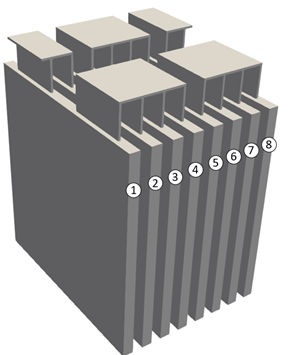
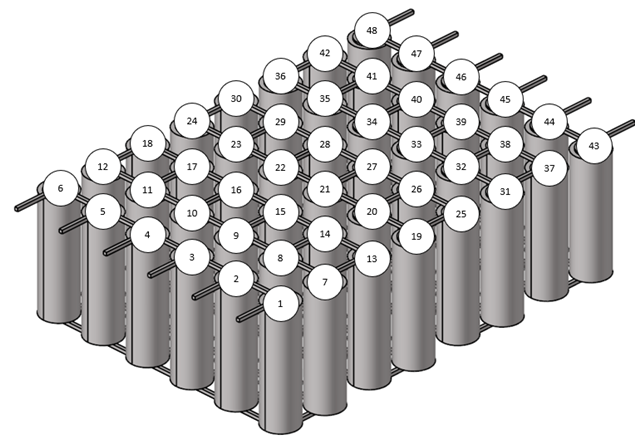
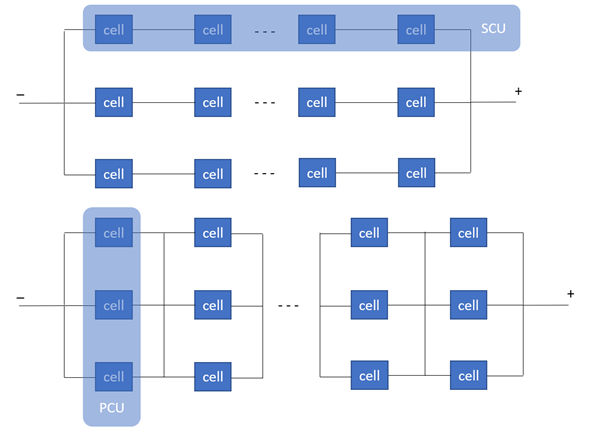

Multi-Battery Module Treatment
In a battery module, batteries are connected in a nSmP pattern, for example, 8s6p, where m batteries are connected in parallel and then n of these parallel connected units are connected in serial to form a pack. In the MSMD method, two potential equations are solved for the and electrical field. Depending on battery connectivity, and could be the potential from the positive current collector or the negative one. Therefore, in a battery module simulation, the two potential equations are solved with the transfer current density changing sign dependent on the location in the module. The cells are alternating as odd and even stages. See figure 4. In tabs and busbars, you only solve for one of the fields. In figure 4, the and on the left indicates which field was solved in the tabs/busbars in the line. The governing equations for the cell scale become:
For in an odd stage:
For in an even stage:
For in an odd stage:
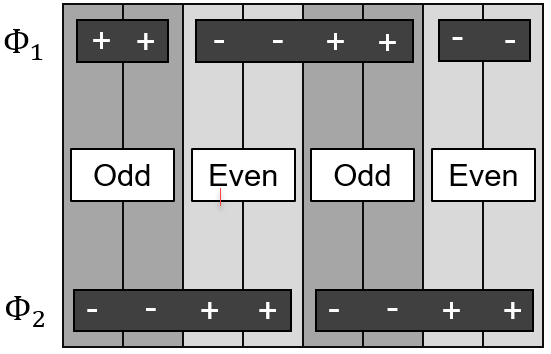
Cell Current/Voltage Calculation in Module

To get current and voltage distribution over each cell, the terminal voltage is separated into a "fixed" part ( ) and a "variable" part.
Everything is known for the "fixed" part from the last time step, the reference potential Vk can be calculated across any PCU based on the following equation. Ik is the pack charging/discharging current, which is an input.
is then used in the subscale model to calculate , , is the polarization resistance and capacitance from the first pair, , is the polarization resistance and capacitance from the second pair, , , , are diffusion resistor current at time step k and k+1.
Electrical Input Type
Different types of electrical input can be included as an input to the battery module using the electrical_input_type command. These are summarized in the following sections.
Current
Current supports both generic charging and discharging, these include: constant; piecewise_linear; cubic_spline; and current profiles.
BATTERY_MODULE( "4S2P battery module" ) {
number_of_parallel_cells = 2
number_of_serial_cells = 4
electrical_input_type = current
current_type = piecewise_linear
current_curve_fit_values = Read( "time_current.txt" )
current_curve_fit_variable = time
cut_off_current_percent = 0.1
maximum_cell_voltage = 4.2
minimum_cell_voltage = 2.7
minimum_cell_state_of_charge = 0.05
maximum_cell_state_of_charge = 0.95
}time_current.txt would look like
this:0 0.66809696
9.61104062 0.66809696
12.5842409 0.66809696
13.34691228 15.37136268
…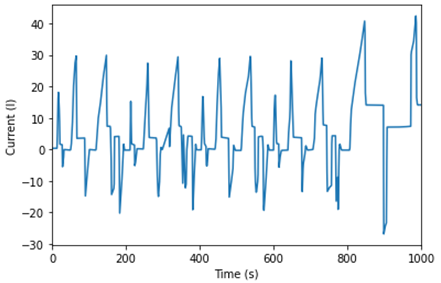

[1] Mahfoudi, Nadjiba, et al. "Thermal Analysis of LMO/Graphite Batteries Using Equivalent Circuit Models." Batteries 7.3 (2021): 58.
C-Rate
C-rate supports both generic charging and discharging, these include: constant; piecewise_linear; cubic_spline; and c-rate profiles.
- Battery with capacity of 3.5Ah discharged at a c rate of 0.5C delivers 1.75A for 2 hours.
- Battery with capacity of 3.5Ah discharged at a c rate of 1C delivers 3.5A for 1 hour.
- Battery with capacity of 3.5Ah discharged at a c rate of 2C delivers 7A for 30 mins.
BATTERY_MODULE( "4s2p battery module" ) {
number_of_parallel_cells = 2
number_of_serial_cells = 4
electrical_input_type = c_rate
c_rate = 1
number_of_parallel_connected_units = 2
}Charging Profiles
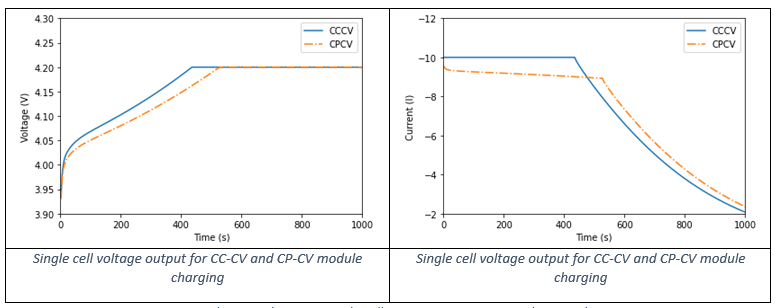
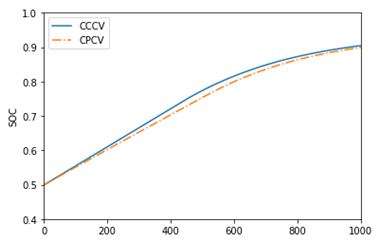
- electrical_input_type = standard_charge_profile
- charging_profile_type = constant_current_constant_voltage
- current/c_rate
- cut_off_current_percent
- maximum_cell_voltage
- minimum_cell_voltage
- minimum_cell_state_of_charge
- maximum_cell_state_of_charge
BATTERY_MODULE( "4S2P battery module" ) {
number_of_parallel_cells = 2
number_of_serial_cells = 4
electrical_input_type = standard_charge_profile
charging_profile_type = constant_current_constant_voltage
current_type = constant
current = -20
cut_off_current_percent = 0.1
maximum_cell_voltage = 4.2
minimum_cell_voltage = 3.0
minimum_cell_state_of_charge = 0.05
maximum_cell_state_of_charge = 0.95
}- electrical_input_type = standard_charge_profile
- charging_profile_type = constant_power_constant_voltage
- power
- cut_off_current_percent
- maximum_cell_voltage
- minimum_cell_voltage
- minimum_cell_state_of_charge
- maximum_cell_state_of_charge
BATTERY_MODULE( "4S2P battery module" ) {
number_of_parallel_cells = 2
number_of_serial_cells = 4
electrical_input_type = standard_charge_profile
charging_profile_type = constant_power_constant_voltage
power_type = constant
power = 300
cut_off_current_percent = 0.1
maximum_cell_voltage = 4.2
minimum_cell_voltage = 3.0
minimum_cell_state_of_charge = 0.05
maximum_cell_state_of_charge = 0.95
}Constant Power (CP)
CP is charging with constant power, for example, power_type = constant.
- electrical_input_type = power
- power
- cut_off_current_percent
- maximum_cell_voltage
- minimum_cell_voltage
- minimum_cell_state_of_charge
- maximum_cell_state_of_charge
BATTERY_MODULE( "4S2P battery module" ) {
number_of_parallel_cells = 2
number_of_serial_cells = 4
electrical_input_type = power
power_type = constant
power = 300
cut_off_current_percent = 0.1
maximum_cell_voltage = 4.2
minimum_cell_voltage = 2.7
minimum_cell_state_of_charge = 0.05
maximum_cell_state_of_charge = 0.95
}Constant Voltage (CV)
CV is charging with constant voltage, for example, voltage_type = constant. The input module voltage divided by the number of parallel cells should be between the minimum and maximum cell voltage.
- electrical_input_type = voltage
- voltage
BATTERY_MODULE( "4S2P battery module" ) {
number_of_parallel_cells = 2
number_of_serial_cells = 4
electrical_input_type = voltage
voltage_type = constant
voltage = 16
cut_off_current_percent = 0.1
maximum_cell_voltage = 4.2
minimum_cell_voltage = 2.7
minimum_cell_state_of_charge = 0.05
maximum_cell_state_of_charge = 0.95
}